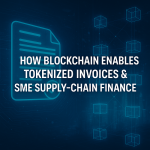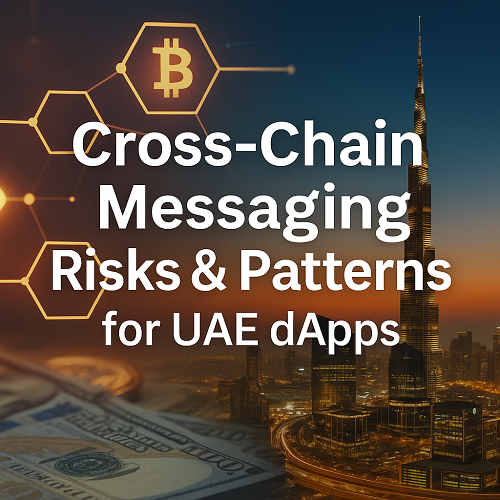Introduction
As Dubai cements its position as a global Web3 hub, blockchain interoperability is rapidly becoming the backbone of the next generation of decentralized applications (dApps). Enterprises and developers are no longer confined to one chain — they operate across Ethereum, Polygon, BNB Chain, and private subnets that host specific smart-contract logic.
This multi-network ecosystem depends on cross-chain messaging — the ability for smart contracts on separate blockchains to communicate and execute actions based on shared data. But while interoperability drives scalability and innovation, it also introduces new security and compliance challenges.
According to Chainalysis, bridge hacks accounted for more than $2.8 billion in losses between 2022 and 2024, highlighting the need for secure architectures. For developers in the UAE operating under the Virtual Assets Regulatory Authority (VARA), the stakes are even higher: bridges must meet standards of auditability, traceability, and resilience.
Cross-Border Payment Infrastructure Just Hit the Blockchain!
Using Kima’s blockchain-based infrastructure, CBI is building a next-gen system for fast, low-cost remittances and international transfers.
From Dubai to the world, cross-border payments are being executed in… pic.twitter.com/WkRll5jiOQ
— Kima Network (@KimaNetwork) September 11, 2025
This guide explores how cross chain messaging UAE projects can safely connect networks, comparing key messaging models, security vulnerabilities, and architectural best practices suitable for Dubai’s regulated Web3 landscape.
Why Cross-Chain Messaging Matters for UAE dApps
Dubai’s blockchain ecosystem covers real estate tokenization, DeFi, logistics, NFT marketplaces, and financial infrastructure. Most of these rely on multiple networks — for example, Ethereum mainnet for liquidity and Polygon for cost-effective microtransactions.
Without secure cross-chain communication, these ecosystems become fragmented. Users face isolated liquidity pools and inconsistent transaction states across chains. Secure messaging allows:
- Instant asset transfers across networks.
- KYC-verified data synchronization between chains.
- Unified governance and staking mechanisms.
- Transparent audit trails that align with VARA’s compliance framework.
Dubai’s Web3 strategy — anchored within the UAE National AI Strategy 2031 — envisions an economy where blockchain, AI, and interoperability converge. As developers pursue multi-chain deployments, secure messaging becomes the critical infrastructure layer.
Understanding Cross-Chain Messaging
Cross-chain messaging is the process through which one blockchain validates and executes messages originating from another. Each message could represent a token transfer, governance vote, or data update.

Three Primary Models
- Trusted Relayer Model
- A permissioned relayer monitors one blockchain and submits proofs to another.
- ✅ Easy to implement; ⚠️ introduces centralization risks.
- Light Client Verification Model
- Each chain runs a light client of the other, verifying block headers cryptographically.
- ✅ High trust; ⚠️ computationally expensive.
- Optimistic Verification Model
- Messages are accepted optimistically but can be disputed within a challenge period.
- ✅ Gas-efficient; ⚠️ requires active monitoring.
For deeper architectural explanations, see Chainlink’s Cross-Chain Bridge Overview, which compares relayer, oracle, and light client architectures and how they manage proof verification.
Popular Messaging Protocols
| Protocol | Approach | Key Strength |
| Chainlink CCIP | Oracle + Relayer hybrid | High security and enterprise adoption |
| Axelar Network | General message passing | Supports EVM and non-EVM chains |
| LayerZero | Ultra Light Node (ULN) design | Balances decentralization and cost |
| Wormhole | Guardian validator set | Fast message propagation |
For example, TaurusHQ’s interoperability report notes that Chainlink’s Cross-Chain Interoperability Protocol (CCIP) combines decentralized oracles with independent relayers to achieve both scalability and auditability — a model suitable for regulated markets like Dubai.
Core Security Risks in Cross-Chain Messaging
1. Smart Contract Vulnerabilities
Bugs in bridge logic (e.g., signature verification or state validation) can be exploited to mint unbacked tokens.
Example: The 2022 Wormhole exploit resulted in $325 million lost due to missing validation checks.
2. Key Management and Multisig Failures
Centralized validator keys or mismanaged multi-signature schemes can compromise entire bridge operations.
3. Oracle Manipulation
Bridges relying on external price feeds or off-chain data can be compromised if oracle nodes are attacked or censored.
4. Replay and Sequence Attacks
If messages lack unique identifiers or nonces, they can be replayed on different chains, duplicating actions.
5. Centralization and Custodial Risks
Relayers or validators concentrating too much authority create single points of failure.
For an excellent overview of bridge vulnerabilities, Chainlink’s guide to bridge exploits lists seven major categories of risk — including mis-signed messages, reentrancy, and verification bypass — that UAE-based developers must consider before production deployment.
Design Patterns for Secure Cross-Chain Messaging

Hybrid Trusted + Light Verification
A common enterprise-grade approach where routine messages use trusted relayers, while critical transactions undergo cryptographic verification.
- Ideal for tokenized securities or regulated DeFi projects.
- Combines flexibility with regulatory auditability.
Multi-Relayer Consensus
Messages are accepted only when verified by multiple independent relayers, reducing the likelihood of collusion or compromise.
Commit–Reveal Protocol
Involves a two-step submission to prevent front-running and message replay.
Zero-Knowledge (ZK) State Proofs
ZK bridges generate succinct proofs of on-chain events, verifiable on destination networks.
- Offers the highest trust and minimal gas cost.
- Example: zkBridge by Polyhedra.
Automated Risk Detection
Emerging research — like the SmartAxe framework on arXiv — explores how static analysis tools can detect vulnerabilities in cross-chain protocols before deployment, providing automated auditing for dApps in regulated markets.
Regulatory and Compliance Considerations in the UAE
Cross-chain messaging in the UAE intersects with financial and data-protection frameworks including:
- VARA (Dubai): Requires traceable token transfers and AML/KYC transparency.
- DIFC and ADGM (Abu Dhabi): Enforce operational risk controls for blockchain-based financial products.
- Data Localization: Sensitive data and keys must reside in approved jurisdictions under the UAE PDPL.
Projects deploying cross-chain messaging under cross chain messaging UAE regulations should incorporate compliance logic directly into bridge governance — for example, whitelisting licensed relayers or maintaining audit trails for regulators. Cross-chain messages often carry sensitive metadata, which must comply with UAE data residency laws for lawful processing
Case Study: Real Estate Tokenization Across Ethereum and Polygon
In 2024, a Dubai-based Web3 startup tokenized property shares using Ethereum for ownership and Polygon for secondary trading. The bridge, powered by Chainlink CCIP, enabled verified cross-chain updates.
Architecture Highlights:
- Ethereum: Managed investor registry and compliance logic.
- Polygon: Handled micro-transactions and yield distribution.
- Cross-Chain Layer: Relayers submitted verified property updates to maintain ownership integrity.
Results:
- Transaction latency reduced by 40%.
- Full on-chain auditability ensured VARA compliance.
- Gas fees reduced by 65% compared to L1-only setups.
Risk Mitigation Strategies
- Multi-Signature Governance: Spread authority across multiple entities.
- Formal Verification: Validate bridge contracts mathematically before deployment.
- Rate Limiting: Cap daily bridge transfer volumes to mitigate exploit damage.
- Event Logging & Monitoring: Maintain immutable logs for compliance audits.
- Insurance Pools: Cover losses via smart-contract insurance mechanisms.
Implementation Costs
| Cost Element | Estimated Range (USD) | Notes |
| Bridge Development | 20,000–60,000 | Includes design and audits |
| Oracle/Relayer Setup | 5,000–15,000 | Integration and uptime costs |
| Compliance Integration | 3,000–8,000 | VARA/DIFC reporting layers |
| Monitoring & Maintenance | 2,000–10,000/month | Security and analytics |
Future Outlook
Cross-chain messaging is evolving from experimental middleware to institutional-grade infrastructure. By 2026, UAE-based Web3 companies are expected to rely on interoperable bridges for tokenization, DeFi, and digital identity. Cross-chain systems can inherit scalability and verification efficiencies from ZK-rollups or Optimistic architectures
Emerging Trends:
- ZK-Powered Bridges: Privacy-preserving verification layers.
- Regulated Interoperability Layers: VARA-certified cross-chain protocols.
- AI-Assisted Bridge Monitoring: Machine learning detecting abnormal message patterns.
- CBDC Integration: The UAE Central Bank’s Digital Dirham strategy could link with cross-chain settlement frameworks, powering instant, compliant transfers.
Final Thoughts
Cross-chain messaging enables Dubai’s Web3 projects to scale across multiple blockchains while preserving compliance and traceability. However, it requires deliberate architectural choices, audited protocols, and clear operational boundaries.
As the UAE accelerates its blockchain strategy, the next generation of interoperable dApps will define the standards for trust and transparency in multi-chain ecosystems.
Work with Websima
At Websima, we specialize in building secure, compliant, and high-performance blockchain systems for enterprises in the UAE. Our expertise spans multi-chain smart contracts, token bridges, and regulatory alignment for Web3 and DeFi businesses.
Whether you’re deploying a cross-chain DeFi product, a tokenized real-estate platform, or an institutional digital-asset exchange, we ensure your system is engineered for security, compliance, and scalability.
Explore collaboration opportunities at https://websima.ae/contactus/.





